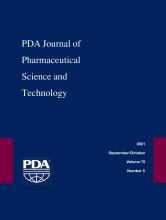Abstract
A statistically robust set of rules is proposed for trending excursions in environmental monitoring data. These rules were designed to minimize false alarms when the process is in control, but signal quickly when the process goes out of control. An adverse trend is an early warning that the system is drifting from normal operating conditions. Prompt action may prevent further deterioration and avoid costly out-of-specification events. Adverse trends are defined as an alert level excursion rate of >2.5% and an action level excursion rate of >0.15%. These definitions were derived from setting action levels at the 99.85th percentile and alert levels at the 97.5th percentile. These percentiles were chosen because they are functional equivalents of control limits and warning limits used in statistical process control charting, which are set at three and two standard deviations above the mean, respectively. In addition, the U.S. Pharmacopeial recommended microbial recovery rates should also be implemented as trend metrics for microbial environmental monitoring of aseptic processing facilities. Occasional isolated alert level excursions may occur even if the process remains in a state of control. However, repeated alert level excursions occurring at a rate >2.5% indicate the process is changing and the system is drifting from normal operating conditions. An adverse trend of alert level excursions should be investigated for root cause. It is critical to determine if an alert level excursion, at its onset, indicates an adverse trend. A total of 24 rules at various sample sizes were tested for their ability to detect an adverse trend at the onset of an excursion using data obtained over a period of 1 year. The rationale for choosing these rules is described.
- Adverse trends
- Alert levels
- Action levels
- Alert level excursion rates
- Microbial recovery rates
- Operational characteristics curves
- Environmental monitoring
- Bioburden tests
- Nonparametric methods
- Average run length
- false positives
- false negatives
- © PDA, Inc. 2021
PDA members receive access to all articles published in the current year and previous volume year. Institutional subscribers received access to all content. Log in below to receive access to this article if you are either of these.
If you are neither or you are a PDA member trying to access an article outside of your membership license, then you must purchase access to this article (below). If you do not have a username or password for JPST, you will be required to create an account prior to purchasing.
Full issue PDFs are for PDA members only.
Note to pda.org users
The PDA and PDA bookstore websites (www.pda.org and www.pda.org/bookstore) are separate websites from the PDA JPST website. When you first join PDA, your initial UserID and Password are sent to HighWirePress to create your PDA JPST account. Subsequent UserrID and Password changes required at the PDA websites will not pass on to PDA JPST and vice versa. If you forget your PDA JPST UserID and/or Password, you can request help to retrieve UserID and reset Password below.






